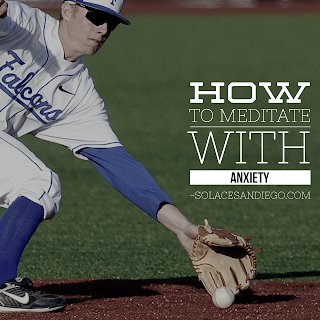How to Meditate with Anxiety
by Kathleen Lisson
I am a certified Meditation Teacher and teach Meditation and Mindfulness at IPSB college in San Diego, but I didn't always meditate. I began practicing meditation during a period of high anxiety in my life. I had just sprained my ankle, forcing me to cancel running a half marathon race which I had been training for for the past three months. I had moved cross-country that past summer for my husband’s job, which meant a career change and I was due to start massage school in a few weeks.
As I sat on the meditation cushion those first few times, I heard all my anxieties surfacing in the quiet of my mind. My sarcastic inner voice reminded me that if I wanted to sit around and be reminded of how disappointed and scared I was, I could do it with a glass of wine instead of paying hundreds of dollars to a meditation instructor. But I didn’t quit. Soon I became more experienced at meditation. I was able to recognize those anxious thoughts before they turned into full-blown stories and let go of my focus on them.
Those first few times, I was feeling the effects of a major meditation misconception - that meditation is going to be like a day at the beach - just relaxing, not thinking, every care magically whisked away.
The reality is that meditation for beginners will always involve thoughts, and often exactly the thoughts we don’t want to think about. Meditation reduces anxiety not by ending anxious thoughts but by allowing them to pass - like a child learning to play catch with a ball. Have you ever seen major league baseball triple play? The ball is in and out of the glove in record time because the players saw the ball coming and were able to recognize it and then let it leave their glove. If anxious thoughts are like a baseball, the goal of learning to work with the ball effectively is to not hold onto the ball.
Watch some great baseball triple plays here:
OK, so we’ll get the ball out of my glove. But first, let’s consider another major meditation misconception this one about the best way to let a thought pass - many beginning meditators think that thoughts during meditation mean they are a failure and that ‘forcing’ themselves not to think and berating themselves when they do is the only way to ‘win’ at meditating.
Watch this baseball fielding video to get an idea of how we should react to thoughts. Bill Ripken only has positive feedback for his young player learning a new skill.
Instead, we let thoughts pass by recognizing and naming them (“thinking” or “this is anxiety”) and returning to the breath. Name, return. Name, return. Name, return. Much like a player catches hundreds of balls during a baseball drill, this process can happen hundreds of times during meditation and it is an essential skill to develop. The magic part is when the skill of recognizing a thought starts appearing in our everyday lives. Instead of getting caught up in anxious thoughts, we begin to recognize them when the first thought comes to mind and are able to label it before it overwhelms us.
Kathleen Lisson is a certified Meditation Teacher and Labyrinth Facilitator and teaches Meditation and Mindfulness at IPSB college in San Diego. Sign up for a private meditation lesson or labyrinth walk in the comfort of your home here: https://www.massagebook.com/San_Diego~Massage~sandiego?src=external






No comments:
Post a Comment